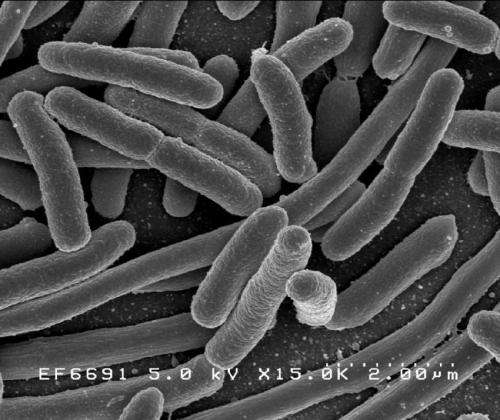
A study to be presented at European Congress on Clinical Microbiology and Infectious Diseases (ECCMID) shows that rates of Escherichia coli related sepsis in different regions of the UK could be directly linked to the levels of pathogenic (disease causing) E. coli in the community, as determined by its presence in sewage in that area. The study is by Dr. Mark Toleman, Cardiff University, UK and colleagues.
UK E. coli sepsis rates have been rising for the last 20 years. Good information on the rates of increase are available from the agencies Public Health England, Wales and Scotland. E. coli bacteraemia (blood infection) rates have been closely monitored since mandatory surveillance was initiated for acute NHS trusts in 2011. For example, rates have risen by 49% in Wales (60.3-89.8 per 100,000 population from 2010-2017), 71% in England (45-77.7 per 100,000, 2009-2018) and 31% in Scotland (66.6-87.3 per 100,000 2009-2018). However, the reason behind this consistent year on year increase is to date unknown.
The sepsis rate also varies greatly between NHS geographic regions and considerably between London (64 cases 100,000 population) and South Wales (85 per 100,000). In this study, the authors tested the theory that the different rates could be due to differing prevalence of pathogenic E. coli types (type B2) in the different UK NHS regions.
Sewage was collected from multiple sites: Longreach (about 20km East of London on the River Thames near Dartford), Marlow (Buckinghamshire), Reading (Berkshire), Bristol (Avon), Ponthir (South Wales) and Cardiff (South Wales) sewage works from the period 19 to 26 September 2019. The authors chose these particular locations to focus the study along the M4 motorway corridor knowing that the sepsis rates were lowest in London and highest in South Wales.
The authors explain: “We were constrained a little by availability to access certain sewage works but essentially we managed to get sewage from the majority of plants targeted. We then randomly chose 100 E. coli isolates from each location and performed genetic analysis on them.”
The average prevalence of pathogenic B2 phylotype E. coli was considerably higher in South Wales than across the English locations, 32.5% versus 17.8%. E. coli B2 phylogenetic prevalence at each location was: Ponthir (33%), Cardiff (32%), Bristol (24%), Reading (16%), Marlow (13%), Longreach (18%) with prevalence lowest in the London region (15.6% overall—an average of the sites that were all within 40 miles of central London: Reading, Marlow and Longreach).
A method called multiplex PCR was then used to detect known sepsis-causing pathogenic E. coli ST95, ST131, ST73 and ST69 (all part of the B2 group routinely found to cause sepsis in hospital). Most sepsis-causing E. coli sequence types belong to the E. coli B2 group, and the prevalence of these specific ST was also considerably higher in South Wales than in England, 11% versus 7.8%.
The highest rate of specific sepsis E. coli ST was found in Bristol mostly due to a very high prevalence of ST95 (9%) in the Bristol community. However overall, Bristol had less of a diversity of sepsis causing ST compared to the Welsh sites, with several additional sepsis-causing types commonly found in Wales.
The authors say “Our study showed that firstly, the carriage rate of B2 types is very high in the UK especially in Wales in this study and secondly, that the specific sequence types within the B2 group known to cause sepsis in our hospitals are commonly carried in the community.”
They further explain: “Most sepsis events start from common community acquired infections such as urinary tract infections (UTIs) that cause bladder and then kidney infections before entering the blood stream (sepsis). The origin of the E. coli organisms causing these infections is typically the patients’ own gut. Therefore, if more people in the community are carrying pathogenic B2 types of E. coli such as ST73, ST131 etc we would expect the UTI rate to increase and also subsequently the sepsis rate. This is exactly what appears to be happening.”
The authors have also done other work in this area, including a study of the UK, Saudi Arabia and Kazakhstan that indicates that the UK sepsis rates are directly related to carriage of pathogenic E. coli types. They have also published data on rates of B2 carriage in Pakistan and Northern India (which are very low in comparison to the UK), and have an on-going study comparing the situation between the UK and South America (Brazil). In addition, they are currently seeking funding to do a UK wide study.
On the root causes of the different rates of E. coli carriage in different places, they say: “Our previous research has shown very low rates of human carriage of pathogenic E. coli strains in other geographic locations such as Saudi Arabia, Bangladesh Pakistan and India (<2%). This may be related to the prevalence of natural E. coli predators such as bacteriophages in different human communities and locations. Similarly, diverse mixes of cultures and ethnicities in global hubs such as London would allow mixing of bacterial and bacteriophage populations altering prevalence of individual E. coli strains.”
Source: Read Full Article